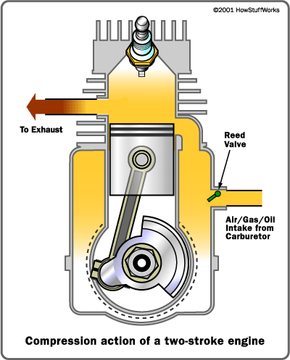Disadvantages of the Two-stroke
You can now see that two-stroke engines have two important advantages over four-stroke engines: They are simpler and lighter, and they produce about twice as much power. So why do cars and trucks use four-stroke engines? There are four main reasons:
- Two-stroke engines don't last nearly as long as four-stroke engines. The lack of a dedicated lubrication system means that the parts of a two-stroke engine wear a lot faster.
- Two-stroke oil is expensive, and you need about 4 ounces of it per gallon of gas. You would burn about a gallon of oil every 1,000 miles if you used a two-stroke engine in a car.
- Two-stroke engines do not use fuel efficiently, so you would get fewer miles per gallon.
- Two-stroke engines produce a lot of pollution -- so much, in fact, that it is likely that you won't see them around too much longer. The pollution comes from two sources. The first is the combustion of the oil. The oil makes all two-stroke engines smoky to some extent, and a badly worn two-stroke engine can emit huge clouds of oily smoke. The second reason is less obvious but can be seen in the following figure:
Each time a new charge of air/fuel is loaded into the combustion chamber, part of it leaks out through the exhaust port. That's why you see a sheen of oil around any two-stroke boat motor. The leaking hydrocarbons from the fresh fuel combined with the leaking oil is a real mess for the environment.
Advertisement
These disadvantages mean that two-stroke engines are used only in applications where the motor is not used very often and a fantastic power-to-weight ratio is important.
In the meantime, manufacturers have been working to shrink and lighten four-stroke engines, and you can see that research coming to market in a variety of new marine and lawn-care products.
For more information on two-stroke engines and related topics, check out the links below.
Related HowStuffWorks Articles
More Great Links
- Small-Engine Emissions Research
- Basic Two-stroke Tuning
- How Two-Stroke Expansion Chambers Work, and Why You Should Care
- Expansion Chambers: Exhaust Pipe "Theory"
- Two-Stroke Technology
